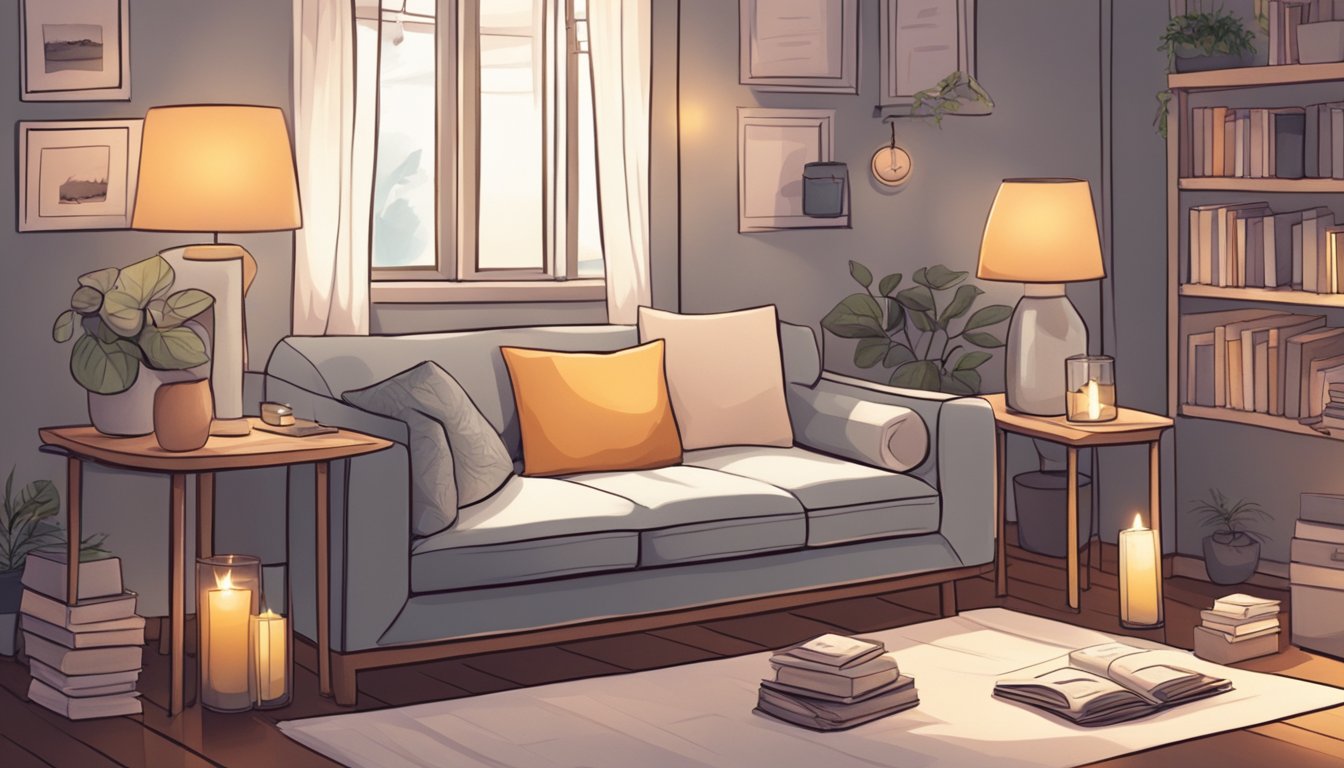How to Do a Silent Retreat at Home: A Beginner’s Guide
Silent retreats have become increasingly popular in recent years as more people seek to disconnect from the chaos of everyday life and find inner peace. However, not everyone has the time or resources to attend a retreat centre.
Luckily, it is possible to create a silent retreat experience in the comfort of your own home. In this article, I will share some tips and tricks for how to do a silent retreat at home.

Setting intentions and preparing your space is an essential first step to creating a successful retreat experience. This involves creating a peaceful environment that supports your practice.
- You can start by decluttering your space, removing any distractions, and setting up an altar or meditation cushion. It’s also essential to establish guidelines for your retreat, such as avoiding social media and limiting your use of technology.
- Daily practices for inner peace are another critical aspect of a silent retreat. These practices can include meditation, yoga, journaling, or simply taking a mindful walk in nature. Nurturing your body and mind through healthy eating, exercise, and self-care practices is also essential.
- Finally, reflection and integration are key components of a successful retreat experience. Taking time to reflect on your experience and integrate what you have learned into your daily life can help you maintain a sense of inner peace long after the retreat is over.
Key Takeaways
- Setting intentions and preparing your space is essential for a successful retreat experience.
- Daily practices for inner peace, such as meditation and self-care, are crucial during a silent retreat.
- Reflection and integration are key components of a successful retreat experience.
Table of Contents
Setting Intentions and Preparing Your Space
Choosing a Suitable Location
When planning to do a silent retreat at home, it is essential to choose a location that is conducive to meditation and silence. Find a space where you will not be disturbed by external noise or distractions. It could be a spare room, a corner of your bedroom, or any other quiet space in your home. Make sure the room is well-ventilated, and the temperature is comfortable.
Creating a Schedule
Setting a schedule is crucial for a successful silent retreat at home. Decide on the duration of your retreat and create a schedule accordingly. Plan your day to include meditation sessions, yoga, and other spiritual practices that you enjoy. It is also important to schedule breaks to rest and rejuvenate.
Gathering Essential Items
To make your silent retreat at home comfortable and enjoyable, gather essential items such as a meditation cushion, yoga mat, water bottle, and candles. Wear comfortable clothing that allows you to sit and move freely. Set up your meditation cushion and yoga mat in a quiet corner of your chosen location. Keep your water bottle and any other necessary items within reach.
In summary, when preparing for a silent retreat at home, set your intentions, choose a suitable location, create a schedule, and gather essential items. By doing so, you will create an environment that supports your spiritual practice and enhances your experience.
Establishing Retreat Guidelines

When planning a silent retreat at home, it is important to establish guidelines to help you stay focused and avoid distractions. Here are some guidelines that I have found helpful:
Defining Boundaries with Family and Friends
It is important to let your family and friends know that you will be on a silent retreat and will be unavailable during this time. Set clear boundaries and communicate them in advance. Let them know that you will not be answering phone calls, text messages, or emails during this time. If you live with others, make sure they understand that you need space and quiet time to fully engage in the retreat.
Digital Detox: Managing Devices and Electronics
To fully engage in a silent retreat, it is important to disconnect from technology and electronics. Turn off your phone, computer, and any other devices that may distract you. Consider setting up an auto-reply message on your email to let people know that you are on a silent retreat and will not be responding to emails until a later time.
Creating Accountability and Trust
It can be helpful to have an accountability partner or mentor who can support you during your silent retreat. This person can help you stay focused, provide encouragement, and hold you accountable to your goals. Make sure to choose someone you trust and who understands the importance of a silent retreat.
By establishing these guidelines, you can create a supportive environment that will help you fully engage in your silent retreat and reap its benefits.
Daily Practices for Inner Peace
When it comes to finding inner peace, daily practices are essential. In this section, I will share with you some of the practices that have helped me find inner peace during my silent retreats at home.
Structured Meditation Sessions
Meditation is one of the most effective practices for finding inner peace. During my silent retreats, I set aside time for structured meditation sessions. I usually do sitting meditation for 30 minutes in the morning and 30 minutes in the evening. I find that this helps me to start and end my day with a calm and peaceful mindset.
Incorporating Yoga and Mindful Movement
Yoga and mindful movement are other practices that can help you find inner peace. During my silent retreats, I incorporate yoga and mindful movement into my daily routine. I usually do a gentle yoga practice in the morning, and I also take breaks throughout the day to do some mindful movement. This helps me to release tension and stress from my body and mind.
The Role of Journaling and Reflection
Journaling and reflection are practices that can help you to gain clarity and insight into your thoughts and emotions. During my silent retreats, I set aside time for journaling and reflection. I usually do this in the evening before bed. I find that this helps me to process my thoughts and emotions, and it also helps me to let go of any negative thoughts or feelings that I may be holding onto.
Overall, incorporating daily practices such as meditation, yoga, and journaling can help you to find inner peace and well-being. These practices can help you to release stress and tension from your body and mind, and they can also help you to gain clarity and insight into your thoughts and emotions. By incorporating these practices into your daily routine, you can create a more peaceful and fulfilling life.
Nurturing the Body and Mind
When doing a silent retreat at home, it is important to take care of your body and mind. Here are some tips to help you nurture yourself during this time.
Mindful Eating and Meal Planning
During a silent retreat, it is important to be mindful of what you eat and how you eat it. Eating mindfully means being present and fully aware of the food you are consuming. To achieve this, I recommend planning your meals ahead of time. This will help you avoid any unnecessary distractions when it comes to food preparation and allow you to focus on your mindfulness practice.
When planning your meals, try to include healthy and nourishing foods. This will help you maintain your energy levels and keep you feeling good throughout the retreat. Make sure you have a balanced mix of proteins, carbohydrates, and healthy fats. Also, try to eat at regular intervals throughout the day to avoid any energy dips.
The Importance of Rest and Relaxation
Silent retreats can be intense, so it is important to make sure you are getting enough rest and relaxation. Make sure you have a comfortable space to sleep in and that you are wearing comfortable clothes. This will help you relax and get a good night’s sleep.
During the day, make sure you take breaks and give yourself time to rest. This can be as simple as taking a short nap or going for a walk. Whatever you choose to do, make sure it is something that helps you relax and recharge.
Remember, the goal of a silent retreat is to give yourself space and time to reflect and recharge. By taking care of your body and mind, you will be able to get the most out of this experience.
Reflection and Integration

Assessing Personal Transformation
After completing a silent retreat at home, it is important to take some time to reflect on the experience and assess any personal transformation that may have occurred. One way to do this is to keep a journal throughout the retreat, documenting any insights, challenges, or moments of inspiration that arise. By reviewing this journal after the retreat, I can gain a deeper understanding of my own personal growth and transformation.
It is also important to reflect on any changes in my mental health that may have occurred during the retreat. Did I experience a greater sense of peace and calm? Did I find new ways to manage stress and anxiety? By taking note of these changes, I can better understand the impact of the retreat on my overall wellbeing.
Carrying the Retreat Experience into Everyday Life
One of the main goals of a silent retreat is to take the experience of inner peace and stillness into everyday life. To achieve this, I find it helpful to identify specific practices or habits that I can integrate into my daily routine. This may include setting aside time for daily meditation or mindfulness practices, or simply taking more time to connect with nature and find joy in simple activities.
Effective communication is also an important aspect of carrying the retreat experience into everyday life. By practicing active listening and speaking from a place of compassion and understanding, I can cultivate deeper connections with others and foster a greater sense of community.
Overall, the process of reflection and integration is key to fully experiencing the benefits of a silent retreat at home. By taking the time to assess personal transformation and identify ways to carry the retreat experience into everyday life, I can cultivate greater peace, joy, and spiritual wellbeing.
Frequently Asked Questions

What activities should I include in my silent retreat at home?
During a silent retreat, it’s important to engage in activities that promote inner peace and stillness.
Some activities you can include in your personal silent retreat at home are meditation, yoga, journaling, reading, walking in nature, and mindful breathing exercises.
Remember to choose activities that resonate with you and bring you a sense of calm.
What are some effective self-care practices to incorporate into a home silent retreat?
Self-care practices are essential during a home silent retreat. You can incorporate practices such as taking a warm bath, practicing gentle yoga, getting a massage, or engaging in a creative activity such as painting or drawing.
Remember to listen to your body and give yourself permission to rest and recharge.
What are some guidelines to follow during a home silent retreat to maintain silence?
To maintain silence during a home silent retreat, it’s important to set clear boundaries with those around you.
Let your family members or housemates know that you’ll be on a silent retreat and ask for their support in maintaining a quiet environment.
You can also put up a sign or note to remind them. Avoid unnecessary conversations or interactions, and limit your use of electronic devices.
How do I stay committed to the silence and structure of a retreat without external guidance?
Staying committed to the silence and structure of a retreat can be challenging without external guidance.
One way to stay committed is to set clear intentions and goals for your retreat and remind yourself of them regularly.
You can also create a daily schedule and hold yourself accountable to it.
Additionally, finding a silent retreat community online or in-person can provide support and accountability.
Remember to be gentle with yourself and trust the process.
How can I create a conducive environment for a silent retreat in my own space?
Creating a conducive environment for a silent retreat is crucial for its success.
You can start by finding a quiet and comfortable space in your home where you won’t be disturbed.
You can also remove any distractions such as electronic devices and clutter.
Consider using essential oils or candles to create a calming atmosphere, and make sure to have comfortable cushions or chairs for sitting.
Could you suggest a daily schedule for a silent retreat carried out at home?
A daily schedule for a home silent retreat can vary based on personal preferences, but here’s an example:
6:00 am: Wake up and practice yoga or meditation
7:00 am: Breakfast
8:00 am: Silent walking or nature time
10:00 am: Journaling or reading
12:00 pm: Lunch
1:00 pm: Rest or nap time
3:00 pm: Mindful breathing exercises
5:00 pm: Dinner
6:00 pm: Evening meditation or yoga
7:00 pm: Free time for personal reflection or reading
9:00 pm: Bedtime






